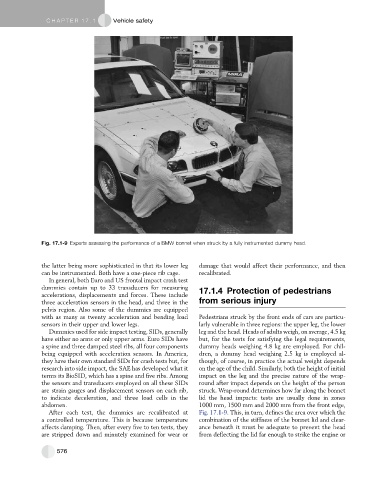Page 565 - Automotive Engineering Powertrain Chassis System and Vehicle Body
P. 565
CHAP TER 1 7. 1 Vehicle safety
Fig. 17.1-9 Experts assessing the performance of a BMW bonnet when struck by a fully instrumented dummy head.
the latter being more sophisticated in that its lower leg damage that would affect their performance, and then
can be instrumented. Both have a one-piece rib cage. recalibrated.
In general, both Euro and US frontal impact crash test
dummies contain up to 33 transducers for measuring 17.1.4 Protection of pedestrians
accelerations, displacements and forces. These include
three acceleration sensors in the head, and three in the from serious injury
pelvis region. Also some of the dummies are equipped
with as many as twenty acceleration and bending load Pedestrians struck by the front ends of cars are particu-
sensors in their upper and lower legs. larly vulnerable in three regions: the upper leg, the lower
Dummies used for side impact testing, SIDs, generally leg and the head. Heads of adults weigh, on average, 4.5 kg
have either no arms or only upper arms. Euro SIDs have but, for the tests for satisfying the legal requirements,
a spine and three damped steel ribs, all four components dummy heads weighing 4.8 kg are employed. For chil-
being equipped with acceleration sensors. In America, dren, a dummy head weighing 2.5 kg is employed al-
they have their own standard SIDs for crash tests but, for though, of course, in practice the actual weight depends
research into side impact, the SAE has developed what it on the age of the child. Similarly, both the height of initial
terms its BioSID, which has a spine and five ribs. Among impact on the leg and the precise nature of the wrap-
the sensors and transducers employed on all these SIDs round after impact depends on the height of the person
are strain gauges and displacement sensors on each rib, struck. Wrap-round determines how far along the bonnet
to indicate deceleration, and three load cells in the lid the head impacts: tests are usually done in zones
abdomen. 1000 mm, 1500 mm and 2000 mm from the front edge,
After each test, the dummies are recalibrated at Fig. 17.1-9. This, in turn, defines the area over which the
a controlled temperature. This is because temperature combination of the stiffness of the bonnet lid and clear-
affects damping. Then, after every five to ten tests, they ance beneath it must be adequate to prevent the head
are stripped down and minutely examined for wear or from deflecting the lid far enough to strike the engine or
576

